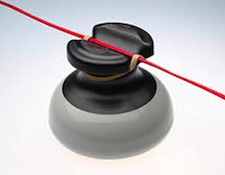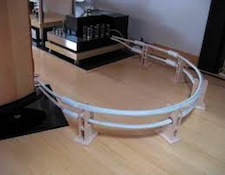It’s the time of year for saving money!
Did you ever hear of a thing called “radio”? Or another one called “television”? Do you believe in them? What would you think of someone who DOESN’T?
 The reason that I ask is that, while few people, if any, deny that radio and television work, there are LOTS of people who think – and are quite vociferous in insisting – that cable lifters are THE looniest of all loony High End tweaks. Even so, all broadcast communications (anything “wireless” at all, including not just radio and TV, but your TV’s remote control, your cellphone, the wireless handset for your home phone, and the Wi-Fi connection for your computer) derive from exactly the same field theory that makes cable lifters work.
The reason that I ask is that, while few people, if any, deny that radio and television work, there are LOTS of people who think – and are quite vociferous in insisting – that cable lifters are THE looniest of all loony High End tweaks. Even so, all broadcast communications (anything “wireless” at all, including not just radio and TV, but your TV’s remote control, your cellphone, the wireless handset for your home phone, and the Wi-Fi connection for your computer) derive from exactly the same field theory that makes cable lifters work.
Do you know how to calculate the dimensions of a field? (No, NOT a corn field, an electromagnetic or electrostatic field) If you don’t, don’t worry; it’s a trick question: Fields don’t HAVE any dimensions. All they have is a point of origin, from which they extend forever, diminishing in strength (intensity) in accordance with the “Inverse Square Rule”.
When you run a current through any conductor, an electromagnetic field forms around that conductor, controlled by the amperage of the current flow,, and, that field extends all the way to the end of the universe (if there is such a thing), never stopping, but just getting progressively weaker as it goes.
If, instead of just a simple DC current, you run an AC signal through your conductor, every time that signal changes polarity (direction), the field will collapse, and the collapse of that field will induce the potential for current flow (There won’t actually BE any current flow unless the conductor is grounded and a circuit can be formed) in any conductor that lies within its range.
 Now comes the fun part: Unless it’s somehow blocked or absorbed, as by, for example, a Faraday cage, any field will extend forever, and EVERY conductor in the universe will, therefore, lie within its range and will be affected by it to a degree consistent with its (the field’s) strength at the conductor’s location.
Now comes the fun part: Unless it’s somehow blocked or absorbed, as by, for example, a Faraday cage, any field will extend forever, and EVERY conductor in the universe will, therefore, lie within its range and will be affected by it to a degree consistent with its (the field’s) strength at the conductor’s location.
That’s the basic principle for broadcast communication: The collapsing field from a transmitting antenna induces a current flow in a receiving antenna some distance away. From that point on, all you have to do is to diddle it a little and, voila; you’re listening to your favorite radio station, talking on your cellphone, or watching Spongebob Squarepants on TV!
Another interesting thing about conductors and fields is that If the conductor that the current is passing through is a wire, and if that wire is insulated (as virtually ALL wires in ALL cables are), then there will be TWO fields formed: The current-controlled electromagnetic field that forms around the wire, and a second, voltage-controlled, electrostatic field that forms around the insulation.
This “two-field” phenomenon leads to still another REALLY INTERESTING thing about fields and wires: If you take two identical lengths of exactly the same wire – even wires cut from the same spool – and give them two different kinds of insulation (PVC on one wire, for example, and PTFE Teflon® on the other) and you measure the velocity of propagation of each of the two insulated wires as a percentage of the speed of light, you’ll find that they are NOT identical, but will display measurable differences.
 Now, the fact of it is that — at least for anything having to do with audio — what a cable’s velocity of propagation is probably doesn’t mean squat, but it IS measurable and there ARE measurable differences. How can that be? If the signal is, as we have been taught, carried by electrons passing through the (metal) of the conductor, and both conductors are exactly the same, how can the velocities of propagation possibly be different? UNLESS THE SIGNAL IS NOT CARRIED BY THE ELECTRONS PASSING THROUGH THE WIRE; which is exactly what was indicated by Maxwell and Gauss well more than 150 years ago. In their thinking, instead of the signal being carried by the wire, it’s actually carried by an “electric field” SURROUNDING the wire: Hark! Could it be that there’s a third field? Or is it that the “electrical” field is just another name or function for the “electromagnetic” field that we already know about?
Now, the fact of it is that — at least for anything having to do with audio — what a cable’s velocity of propagation is probably doesn’t mean squat, but it IS measurable and there ARE measurable differences. How can that be? If the signal is, as we have been taught, carried by electrons passing through the (metal) of the conductor, and both conductors are exactly the same, how can the velocities of propagation possibly be different? UNLESS THE SIGNAL IS NOT CARRIED BY THE ELECTRONS PASSING THROUGH THE WIRE; which is exactly what was indicated by Maxwell and Gauss well more than 150 years ago. In their thinking, instead of the signal being carried by the wire, it’s actually carried by an “electric field” SURROUNDING the wire: Hark! Could it be that there’s a third field? Or is it that the “electrical” field is just another name or function for the “electromagnetic” field that we already know about?
Hmmm, if two identical wires WITHOUT insulation both carry their signal in an electrical field surrounding the wire and both have the same velocity of propagation, and two identical INSULATED wires, both carry their signal in an electrical field surrounding the wire and, with two different kinds of insulation, have two different velocities of propagation, then whatever is making the difference must have something to do with the insulation, right? But the insulation, in both cases, is INSULATION – a NON-conductor — and is incapable of carrying either current or signal. So what’s making the difference?
It’s possible that, with no actual electron-transfer happening between the conductor and its insulation (its “dielectric”), the measured differences are due to interactions between the current-controlled and voltage-controlled fields. It’s also possible that the differences arise from something else entirely. There can be no doubt, however, that 1) whether we’re talking about simple insulated wires or sophisticated complete cables, there ARE fields surrounding them that extend forever; 2) if, a la Maxwell and Gauss, it’s a field that’s actually carrying the signal, then the dielectric is SOMEHOW interacting with it to slow down (it can never be ‘speeded-up”) its velocity of propagation as relative to the speed of light, and 3) (Here we actually come to the meat of it) If the dielectric interacts with the field(s) to change the signal, and the field(s) extend forever, then EVERYTHING in the universe that isn’t a grounded conductor must be part of the dielectric.
Q.E.D. And so what?
That question will be answered next week, in Part 2. Come back and find out!





